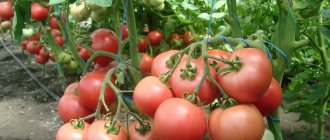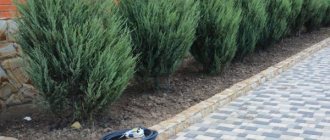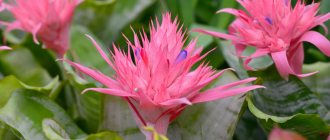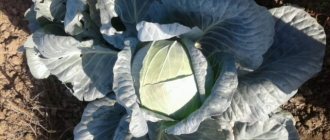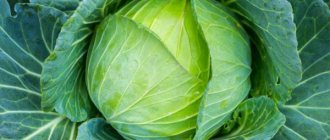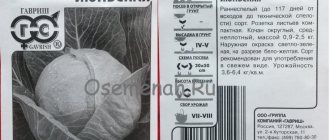Amager or Amager 611?
Beginner gardeners often ask what the cabbage is called: Amager or Amager 611? It must be said that both names are correct. Initially, VNIISSOK developed a variety whose name included numbers. It was intended for planting in all regions of our vast Motherland, with the exception of the northernmost corners, where the late garden crop does not have time to ripen.
But after some period of time, small varietal changes occurred. Amager 611 cabbage seeds, which were collected in the southern regions of the country, became more resistant to elevated daytime temperatures. The crop has little resistance to the effects of drought. At the same time, all the main varietal characteristics were preserved in full. This “subvariety,” so to speak, began to be called without numbers.
Now on the territory of the Russian Federation, most often, if not everywhere, you can find bags of Amager 611 seeds. In Moldova, Kazakhstan, Ukraine and other former Soviet republics, in most cases Amager cabbage seeds are found on the shelves of agricultural stores.
Cabbage care
Caring for cabbage in OG consists of the following activities:
- Loosening the soil.
- Hilling up.
- Polivov.
- Fertilizers for crops.
After the seedlings have been moved to a permanent location, they need to be watered every 2 days for 14 days. It is also important to water cabbage in July-August. At this time, heads of cabbage are setting and the plant needs a lot of energy.
You need to water the vegetable with warm water (cold water can cause a vegetative delay), in the morning or evening, when the sun is hidden below the horizon (to prevent burns). You should try to pour water at the root, without getting on the leaves. It is for this reason that the drip irrigation system is considered the most preferable.
Approximately 3 weeks before harvest, watering is stopped. This will reduce the risk of possible cracking of the heads and increase the keeping quality of the “heads”.
Weeding and loosening
The area must be kept clean. Weeds greatly inhibit the development of agricultural crops, drawing nutrients and water from the soil. To get rid of weeds, it is necessary to periodically weed.
Also, you need to loosen the soil. After frequent watering, the soil becomes compacted, and the cabbage root system begins to suffer from a lack of oxygen. Loosening allows you to solve this problem.
Read also: Winter garlic Komsomolets: description of the variety and reviews from summer residents
To get really large heads (about 4 kg), it is necessary to fertilize the plant. Immediately after moving the seedlings into the ground, it is advisable to water the sprouts with a solution of 10 liters of water, 10 g of urea and 20 g of superphosphate.
It is also worth noting that different feedings have different effects on the crop. For example, nitrogen-containing fertilizers are ideal for gaining leaf mass, while phosphorus-potassium fertilizers promote the formation of a head of cabbage. Therefore, during the “head” formation phase (after July), nitrogen-containing fertilizers cannot be used.
Harvesting
After the first frost hits (night temperatures drop to -2 degrees Celsius), you can begin harvesting. It is impossible to overcook the heads of cabbage during this period, since if they freeze, their keeping quality will significantly deteriorate.
It is best to store the crop indoors, where the air temperature is within -1...+1 C.
Description
The description of Amager cabbage must begin by indicating that it is a late-ripening variety. Forks should be collected 150-175 days after the emergence of mass shoots of the crop. The rosette is formed of a semi-spreading type. The leaves are wide, semi-concave, well raised from the ground. The edges of the leaf blade are rounded with barely noticeable teeth, more reminiscent of a wavy line. The color of the leaf is gray-green with a pronounced waxy coating. There is no wrinkling.
The head of cabbage is formed of impressive size, on average 2400-4000 g. The outer stump is of medium length, the inner one is small. The fork is formed as a very dense, rounded-flat, sometimes rounded-concave or rounded. Cabbage yield is high - up to 6 kg/sq. meter. Suitable for growing on an industrial scale. In this case, the yield reaches 65 tons/ha. Plants develop evenly, so mechanized harvesting is possible. Tolerates transportation well.
Flaws
The disadvantages include the following factors:
- Susceptibility to various diseases;
- Poor development in high temperature conditions. Only abundant and daily watering will help to save a plant in a hot region;
- During winter storage there is a high risk of plant disease from black rot and vascular bacteriosis.
Thus, growing Amager cabbage, subject to certain rules, is not difficult. Abundant watering, timely fertilizing and prevention of various diseases and parasites will help ensure a rich harvest.
Peculiarities
When writing a description of the Amager cabbage variety, mention should be made of its features. Among the advantages, undoubtedly, it is necessary to highlight increased shelf life. The fruits can be stored until April. At the same time, the taste will only improve. If at harvest the taste rating is only 3.5 points, then after 2-3 months of storage it increases to 4.5 points.
Resistance to cracking and frost resistance should also be emphasized. Planting seeds and seedlings in the ground is possible even on the eve of late spring frosts. Forks ripening in beds can tolerate up to minus three degrees Celsius.
The disadvantages of the variety are its susceptibility to some cabbage diseases. In particular, with inept agricultural technology, there is a risk that the forks will catch black rot (fusarium) or vascular bacteriosis. During storage, punctate necrosis may also occur.
Also in the description of Amager 611 cabbage, it must be emphasized that there is such a drawback as the inability to tolerate extremely high temperatures. With prolonged exposure to forks, growth stops and needs abundant watering.
Prevention of diseases
The Amager variety is susceptible to various diseases. Among the dangerous ones is fusarium wilt, which can occur immediately after seedlings are planted on the ridges. There is also weak resistance to bacteriosis and, during storage, to necrosis.
Main diseases of the Amager variety, prevention and treatment
| Disease | Symptoms | Treatment | Prevention |
| Fusarium wilt | Yellowing of leaf blades, loss of elasticity. In the lower leaves, tissue chlorosis is observed between the veins. The plant withers, the leaves fall off, and only the stalk remains. The symptoms are similar to those of vascular or clubroot bacteriosis. | Spraying plants with Immunocytophyte, Agat-25. Removing damaged plants from the ridge and burning. Disinfection of soil after removing bushes. | Compliance with crop rotation and agricultural practices. Mandatory disinfection of seeds, soil on ridges, soil for seedlings. Spraying plantings with a solution of Immunocytophyte, Fitosporin, and Agat-25. |
| Vascular bacteriosis | Yellowing of the leaf blade, blackening of the veins and the formation of a black mesh (black rot). Tissue death, wilting and death of plants. Black rings are visible on the cut of the stem. | Treatment of cabbage bushes with Fitolavin-300. Destruction of diseased plants. Spraying cabbage with Planriz and Binoram (according to instructions). | Pre-soaking the seed material before sowing in a solution of the drug Agat-25, Fitolavin. Maintaining rotation of crop plantings on the site. Control of pests that spread infection to cabbage plantings. |
| Point necrosis (affects cabbage heads during storage) | The infection affects plants in the field, and outbreaks are detected during storage. Grayish or black dots appear on the leaves, merging into spots. The head of cabbage loses its presentation and taste deteriorates. Not suitable for recycling forks. | Heads of cabbage damaged by infection are removed from storage. Not used for food. | Regulation of nitrogen fertilizer dosage during fertilizing. Spraying plantings with solutions of microelements to increase immunity. Compliance with the irrigation regime. Mandatory inspection of heads of cabbage when stored in basements. Ensuring optimal storage temperature. Maintaining rotation of planting crops in the garden. |
The Amager variety will not cause any trouble when growing if you follow the recommendations of agronomists. Full care with the application of fertilizers according to the norms, moderate regular watering, loosening - all this will allow you to get a high yield and save it until spring.
Treatment of plantings on ridges with compositions according to folk recipes will help get rid of pests:
- tobacco decoction;
- ash infusion;
- dry mixture of black pepper, mustard powder.
Marigolds, dill, calendula, and other plants with a pungent odor that repel insects are sown near cabbage. Chemicals are used for large numbers of pests, strictly observing treatment standards.
Agricultural technology
This cabbage is planted for seedlings at the end of February-March. Seeds can be sown in open ground as early as the first days of April (in the southern regions) and in the last days of April (in central Russia). In more northern regions they are planted only by seedlings. The seedlings are ready for planting 40 days after germination.
This cabbage should be planted at a distance of 60-70 cm from each other. The seeding depth is 1.5-2 cm. When planting fresh (!) seedlings, the cabbage stem can be immersed before the leaf blades begin.
This variety is moisture-loving. Therefore, watering should be carried out at least 2 times a week. If the root area is mulched, you can water it once a week. Due to the highly raised leaves, it requires hilling. It responds well to this method of agricultural technology and forms a powerful root system. Fertilizing has a beneficial effect on cabbage. They should be carried out at least 2-3 times a month.
Collection and storage
The variety is ideal for long-term storage. You can harvest when the cabbage leaves are rough. In April, you will be able to enjoy the ideal taste of the fruit, without a hint of bitterness. When properly stored in winter, the variety will ideally resist possible mold and rot.
The only thing that threatens cabbage in winter is spot necrosis, which can be avoided by adhering to the main rules for storing your crop. To store them, the heads of cabbage are inspected to detect rot and, if necessary, dried additionally.
Reviews
Reviews about Amager cabbage are very different. Someone complains that the variety is very susceptible to Fusarium wilt. For some, it even begins literally immediately after the formation of the head begins. Others report that diseases are nothing, but the bitterness in the leaves persists for the first 2 months and is felt very strongly. But both of them confirm the high, stable yield of Amager cabbage. However, judge for yourself whether this variety is suitable for you or not.
Natalya, Odessa region The variety is not bad, I have been growing it for many years. Forms heads of cabbage together, 3-4 kg each. Sometimes there are heads weighing 6-8 kg, but this is rare. It lies in the cellar until spring, then you need to peel off the top leaves - it begins to rot.
Oleg, Voronezh region Amager cabbage was grown by my grandfather. Excellent variety, I like it. True, sometimes the roots of purchased seedlings rot. You just plant it, and after a couple of days it starts to rot. I stopped buying seedlings, my wife began to grow them herself, pre-treating the seeds, and they forgot about rotting. For prevention, I also treat the cabbage area with Trichodermin. Pah-pah, but so far it helps.
Valery, Chelyabinsk region I grow Amager 611 in a greenhouse. I have no complaints about the variety. It grows well, sets large forks, and is stored for a long time. Nice cabbage!
Purpose of application
We can safely say about this variety that the longer it sits, the better the taste - as indicated in the reviews of summer residents. The bitterness that is present in the leaves immediately after harvest disappears a month later, leaving only a pleasant taste and increasing juiciness.
Late varieties are ideal for sourdough and fermentation, because by mid-autumn they accumulate a huge amount of useful components. Sourdough - in this case, the preservative is lactic acid, which is obtained naturally as a fermentation product.
And the fermentation process itself is carried out thanks to the sugars that are present in the vegetable, resulting in a pure taste of the product - this is very beneficial for the body. You need to ferment cabbage in small oak barrels or enamel containers.
It should be stored at a temperature of 4-5 degrees. Salting - by adding salt, the process of proliferation of unnecessary bacteria is blocked. Salted cabbage is very useful, in particular during various viral outbreaks. It makes the immune system stronger.
About
Summary varietal characteristics
| Variety or hybrid | variety |
| Ripening period | late |
| Kochan | rounded flat, dense |
| Kocheryzhka | small |
| Disease resistance | susceptible to fusarium wilt, vascular bacteriosis |
| Fruit weight, g | 2400-4000 |
| Growing areas | from the southern regions of the Russian Federation to the Urals, as well as Ukraine, Moldova, Kazakhstan. |
| Disembarkation scheme | 60-70cm x 60cm |
| From germination to ripeness | 150-175 days |
| Seed placement depth | 1.5-2 cm |
| Seedling age | 40 days |
| Soil temperature for planting seeds/seedlings | +4/+12 |
| Advantages | can be stored for a long time, is transportable, produces a stable high yield |
| Flaws | demanding of soil fertility, moisture-loving, cannot tolerate high temperatures, not suitable for pickling in the first 2 months after harvesting |
Growing seedlings
Almaguer seedlings are planted at the end of February or March. The pot with seeds should be covered with film, ensuring a greenhouse effect. At a temperature of 20-25 degrees, seedlings appear on the fifth day.
Then it needs to be moved to a cool place. If this is not done, the plant may wither and die. After 2 weeks, the seedlings can be planted in separate containers.
Important! It is necessary to water the seedlings every day in the morning with warm water.
When the third leaf appears, you can feed it with fertilizer once, and when the fourth leaf appears, a second time.
Ripens from September to October
Cabbage Amager 611:
- About the variety. White cabbage Amager 611 (lat. Brassica Oleracea VAR. Capitat Amager 611) is a late-ripening variety with good keeping quality. Ripening period September - October. The size of the head of cabbage reaches 4 kg. The fruits are round-flat and green-white when cut. Popular among gardeners.
- Landing. It is recommended to plant seedlings. The ripening period is long, 150 days from planting to harvest. Seeds for seedlings should be sown 50 days before planting in open ground. In the southern regions of the country, you can sow seeds directly into the beds.
- Care. The plant is moisture-loving and requires good fertile, slightly acidified soils. The variety is not recommended for planting in the Northern and East Siberian districts due to its long ripening period. Conduct pest control in a timely manner to preserve the harvest.
Video: the Vsesorta.ru channel recommends the Amager variety for planting, which has the best taste.
Growing conditions
As mentioned earlier, Amager 611 is grown everywhere in two ways, excluding the northernmost regions of Russia - there the heads of cabbage do not have time to ripen.
- Sowing seeds in the ground.
- Sowing seeds for seedlings.
The seeds are planted directly at the end of April, while in regions with cold climates it is advisable to grow cabbage only by seedlings. The agricultural technology of sowing is as follows. Cabbage seeds are sown for seedlings in late March - early April, while the grown seedlings are transplanted into open ground starting from the end of April. Growing times vary in different regions.
Watering plants
To obtain a good harvest of Amager cabbage, constant, abundant watering is important. Use water heated to summer temperature. Cold water will delay plant development and harvest. Usually, cabbage seedlings are watered at the root in specially prepared holes - a hole is made around the trunk of the crop, raising the soil along the edges so that the water does not leak out. It is not recommended to pour water on the leaves - it will cause sunburn.
Two months before harvesting, watering is reduced in order to prevent cracking of ripe heads of cabbage. Watering is stopped completely within a month.
To reduce water consumption when watering around plants, mulch the soil. In such soil, fewer weeds grow, and watering is reduced to once a week.
Plant nutrition
Fertilizers are applied at least once a month. 2 weeks after planting the seeds, the seedlings are fed with a mixture of urea and potassium fertilizers, superphosphate and water in a ratio of 10:20:10.
When planting seedlings, organic fertilizers are added to the holes. Subsequent fertilizing is carried out no earlier than 15 days after planting the seedlings in the ground. The following materials are used as fertilizers:
- rotted grass,
- compost,
- mullein,
- chicken droppings,
- potassium chloride,
- superphosphate,
- urea,
- boric acid,
- wood ash.
These fertilizers are alternated with each other or used in combination - 2-3 fertilizers once a month.
Late feeding in August is carried out to increase the winter storage period and improve the quality of late heads of cabbage. For this purpose, potassium, nitrogen, mullein, and boric acid are used.


